#miyako odori
Explore tagged Tumblr posts
Text
Miyako Odori - Shika Odori 1923
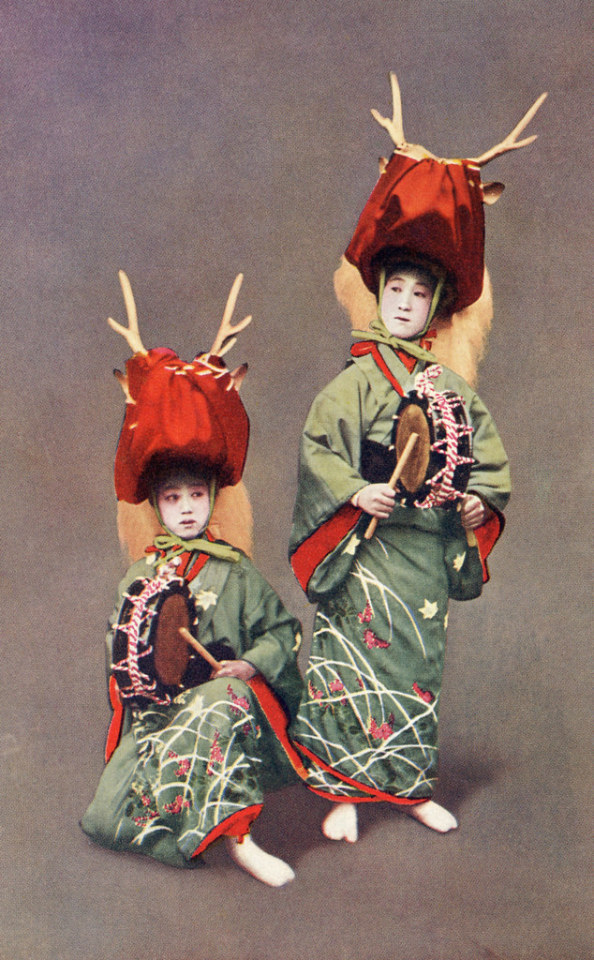
The Shika-odori or Shishi-odori (Deer Dance), being performed by the geiko (geisha) and maiko (apprentice geisha) of the Gion Kobu geisha district in Kyoto, during the annual Miyako Odori (Cherry Dance) of 1923.
#Miyako Odori#Shika Odori#japan#fashion#japanese#kimono#1920s#Shishi-odori#geiko#geisha#maiko#Gion Kobu#kyoto#dance#asia#asian
64 notes
·
View notes
Text
omg I always forget one important detail with the Kobayashi family: they want nothing to do with the Gojo Clan. This isn't out of malice, they are in fact, terrified of them. Primarily, it is such a strong lineage that it exposes them into the focal point of Jushiki society where they prefer their privacy in order to protect those around them. No one is allowed to take contracts from the clan, by doing so, you are exiled. There is no argument either, it is an instant banishment while being stripped of the Kobayashi surname && removed from Gion which to them is a fate worse than death.
#// infinity limits miyako odori so they can't steal the six eyes face either#// it comes out distorted or a blur#// this is why no kobayashi has married into the family they're just: omg no#// they're so funny master assassins but they see blue eyes then have to go the opposite way#––– ❛ out of character �� daddy needs to fake his death again 】
3 notes
·
View notes
Note

Hey MissMyLoko, just curious, why does the Maiko in the far right look like a Geiko instead of a Maiko, who is she? Take a closer look, she looked older than other Maikos.
That's because she is a geiko! She is Mameka (豆花)! Both maiko and geiko perform in the Sou Odori number during the Miyako Odori ^^
25 notes
·
View notes
Note
If a geisha doesn't want to wear a wig, can she tie her hair?
Do you mean Nihongami like Maiko/Hangyoku wear it? I suppose in Hanamachi with less strict rules, it's possible (three Geisha from Oi/Omori in Tokyo, who were active in the late 2000's to late 2010's, wore their own hair in Nihongami frequently). Also Shin Nihongami is possible to create without the help of a Kamiyui, if you're skilled enough. But since I don't have back pictures of those respective Geisha, I don't know what exact hairstyles they wore.

Kyoto Geiko wear Chû shimada/Kyofu shimada done with their own hair for Miyako Odori and Tea ceremony at the other Odori. In this case, if you see a senior Geiko having her own hair styled this way, she chose this over wearing a wig. Junior Geiko don't have this choice. When Odori season is over, they go back to their usual styles of Katsura or Yohatsu.

Yohatsu isn't technically Nihongami, but it's done with your own hair. It's the everyday look for jikata, Geisha who have aged out of Katsura+Oshiroi, or Geisha who live in cities where the combination of Katsura+Oshiroi is only worn for special occasions like the new year, or not at all. Outside of the Hanamachi, it's a popular hairstyle for wearing Kimono. It is also a hairstyle that Geisha can do themselves, although I suppose, at least in Kyoto, they mostly let a professional do the job.

For more casual occasions - like lessons or Miyabi-kai, especially junior Geiko wear a hairstyle more simple than Yohatsu: combed back, or with a side part in a bun (sorry, don't have any pictures available).
27 notes
·
View notes
Note
What's your favorite souvenir or piece of memorabilia you've bought or been gifted?
Thanks for sending an ask earlier!
This is really hard for me bc I JUST came back from a good vacation and I....obtained many souvenirs which might rank now.
My latest favorite is a purse made from the same fabric as the obis Geiko were wearing during the Miyako Odori performance that i saw. It was like going to see Olympians of performing arts. Geiko are INSANELY talented and I was in complete awe of the skill and precision of the whole performance.
I don't have a picture of the bag (and it's in my new apartment but I'm still packing up the old place which is where I am ATM) but this is the flyer illustration which shows the red obi:



And then the displays at the theater.
8 notes
·
View notes
Text
Pearl of Gion: Return of the Miyako Odori - NHK WORLD-JAPAN
Gion, the traditional entertainment district of Kyoto where maiko and geiko have entertained for centuries, faced years of uncertainty when the pandemic closed doors. A large-scale dance performance signals a return to happier times, and for some their first chance to step into the spotlight.
2 notes
·
View notes
Text
Anyway, here is Hatsuko aka: Mamagumi.
Hatsuko is the youngest daughter to Kobayashi Sadako, one of the few elders of the clan who was known for her rather plain features && kind heart. Her eldest sister Anzu was considered a studious woman that maintained the Kobayashi’s sole source of income; their prized Okiya. Hatsuko on the other hand being a rare gem was instantly pushed to become a Maiko, enduring the taxing yet emotionally training of shikomi only to excel in her natural state of dance.
She is the descendant of Nure-Onna, thus, known to be fearsome in her position. Hatsuko is said to exhibit signs of the snake like yokai from a split pupil to fangs when in her ‘natural’ face. She, like many other young women of the Kobayashi Clan are able to disguise themselves with the illusionary technique that most are equipped to handle; Miyako Odori. By doing so, Hatsuko has enhanced her beauty to fit her viperous nature.
Out of the rest of the women in the Kobayashi Clan, she is the weakest. Hatsuko only ranks at a grade level two sorcerer, she is not meant for combat, though her scheming nature has managed to secure her status.
At the age of nineteen she was considered Gion’s top earning Geisha, by doing so, she would assure her family only knew riches. The Kobayashi Clan would therefore go on to welcome a new era; the Lady of Gold Coin doubled their wealth making them an impossible family to contend with.
Hatsuko was deeply hated in Gion despite her popularity; she is foul tempered, mean of mouth, spiteful for her existence that was bound to traditionalism. In the securing of her future, she would forfeit the entirety of herself, thus, none could have her heart && she would assure all would know her wrath for it.
At 24 she would take hold of the status of Matriarch, leading her family into prosperity, while most find her to be a tiresome woman to deal with; they will not dismiss her achievements, beauty, along with ability to provide. Hatsuko on the other hand was in the throes of grieving her sister who had been exiled from the family, she would feel alone, unsafe, in the company of wolves that would now deem her too inferior.
There is a kindness to Hatsuko though, she would welcome her sister’s daughter taking the child as her own && raising her essentially. A prodigy from Hatsuko was considered to be valuable as the child would inherit her talents but not her personality. None would ever know she would have an illegitimate child, safely tucked away with the Gojo Clan, to this day, Hatsuko does not speak of it despite it being the greatest of sorrows && greatest joys.
In the moments where she was able to be ‘normal’ with Megumi, she would show him shadow puppets with her hands. It’s unclear if this was her way of encouraging his CT at the time, Hatsuko would compare her child to be a typical Zen’in blooded child, he had a wolfish smile. Yet, she would often state he is inherently hers, but wanted him to grow without fangs so he would never suffer the cruelty she endured && be loved instead of loathed.
She is the epitome of the horrors that we commit for love, she finds herself to be an unlovable woman but not once did she ever show cruelty to her children. All she has ever done is to ensure their lives were prosperous even at the cost of her own happiness. While many attest Hatsuko has no heart, she would utter, there is truth - she gave what was left of it to Megumi && her niece, it remains with them.
Her signature scent is Jasmine, she has a pension for jazz music && likes to groan that every tiresome nuisance causes her to age 10x more. Hatsuko’s color scheme is Autumn colors to match her red hair. Unlike the rest of her clan who are known to drink to keep up with clients, she tosses her liquor && replaces it with soft drinks, she hates the taste. Hatsuko’s special skill is mahjong, she installed game night in order to boost morale in the family, but it ends in squabbling aunties.
Hatsuko does have a CT that is more shield based; wreathe of snakes. Casting an illusionary tactic to summon a wall of vipers in order to shield herself so she may escape danger.
#OC INFORMATION.#// do you know how powerful it is for Hatsuko to say yes she is aware she has no heart#// megumi has it and it's safe with him ????#// the relief he did not inherit anything of her but the gentleness she showed him as a baby ;A;#// i'M GOING TO BE SICK#KOBAYASHI HATSUKO HEADCANON TAG.
4 notes
·
View notes
Text
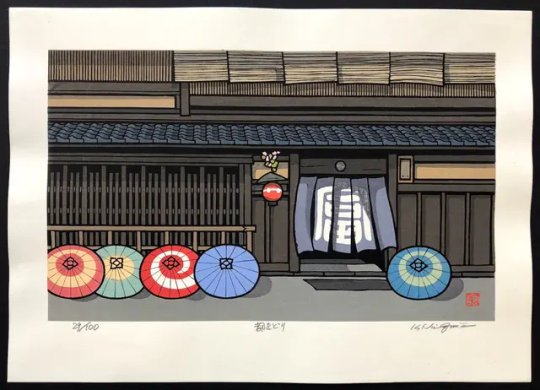
"Miyako Odori" (Miyako Odori Festival)
by Katsuyuki Nishijima. Printed in 2011.
12 notes
·
View notes
Text






𝐅𝐀𝐓𝐄 𝐖𝐄𝐀𝐕𝐄𝐑
Name: Kobayashi Sayuri Age: 27 Height: 4’8 Eye color: jade green with the inner iris a pale wisteria color Hair: pale white, originally a deep onyx black that began to fade as she reached six years old. Naturally wavy with an unruly nature, Sayuri works to keep it straight either plated in elegant styles or parted in the middle where it may hang in a curtain fashion. The length of her hair skims past her backside reaching mid thigh indicating she rarely if ever cuts it. Rank: Special grade Namesakes: Lady of Gion, Daughter of the Celestial Heavens, the Spider Queen. Usagi or Yuri by those close to her, uttered in sweetness. Birthplace: Fushimi Prefecture, currently raised in Gion, Kyoto Occupation: Owner of Tsubaki Cafe, part time martial arts teacher at Kyoto Tech Noticeable marks: Scar on her sternum, laceration mark that indicates a puncture wound, gained in the Past Arc. Spider bites that she opts to wear clear rings or small thin bands, singular birdcage on her left index finger, slender delicately shaped spider lilies crawling up the curvature of her spine contrasted in red. Post Shibuya her legs are noted to be burned along with the flames licking up around her wrist, by then, she opts to wear longer sleeved clothing. Both her collarbones are pierced with small dermal jewelry, along with both hips racking in rows of four. Primary colors: gold, sunny yellow, bone white, cherry blossom pink, pearlescent white Misc information: Sayuri is meant to be a first year during the Past Arc, she would be introduced with Nanami Kento and Yuu Haibara. The shy but friendly young girl from Kyoto with a peculiar dialect and abnormal strength.
Early life: Born to Kobayashi Anzu && Umeda Minato, Sayuri like most daughters of the Kobayashi Clan would not be raised by her biological parents. By the laws of their ancestors, all young girls were to be co-raised underneath the grand wisteria tree that stood testimony to their legacy. Coddled in the arms of her grandmother, Sachiko && co-raised by her biological auntie, Hatsuko, Sayuri was considered a peculiar young child. While most of her cousins were prepped to inherit the family's trade be it in assassination or the art of Geiko, she was noted to lack the finesse most young girls of her bloodline exhibited. Though, it was not of concern, for the Kobayashi women rejoiced in the notion that together as one, they were powerful.
Sayuri had a gift that was not witnessed in over 200 years, one that thrust her into a future that would grant her everything she could desire, the inheritor of Jorōgumo, rarely seen, rarely born, exhibiting total power && the clan’s former weaponry in ruling with an iron fist. Though, the girl was too small, too weak, instead of becoming the spider she would be entangled in the webs && in exasperated sighs many believed that their own was no good, failed to acquire any cursed energy when she was merely a late bloomer. Though they loved her all the same, promising in hushed whispers if she could not flourish as their next successor, she would become the envy of all entertainers.
Past Arc: In a bid to calm the tides of gossip, rumors, ect that the young Kobayashi heiress was merely mundane, Sachiko believed it would be best to send Sayuri away from the rampant conversations. None of their kin had left their ancestral home, but in a bid to protect her granddaughter, Sachiko urged Sayuri to leave && join the modern day society. Fearful of life outside of the world of Willows && Flowers, Sayuri would head off to Tokyo, while her cursed energy was lacking fundamental basics she exhibited a tremendous amount of inhuman strength. Slowly growing, the young girl was given the foundation to inherit her clan’s precious technique; Miyako Odori. Sachiko had joked, even the weakest of their bloodline could essentially blossom with understanding this sacred knowledge. It was an assassin’s tailored trait, as the family did not intervene in the law of protecting man but ending quarles && keeping the peace by becoming hired blades.
Over time, Sayuri grew her abilities by learning how to camouflage her entire visage, Miyako Odori consisted of ‘tiers’ through which the user was granted the ability to switch their persona. In a flurry of jubilation, the young girl had altered her green eyes to become a hue of pale jade, cosmic && sweet as she dealt with a crisis of person, trying to understand her position in this strange world while navigating the accursed blood in her veins. The time she spent in Tokyo placed her between the other first years, acting as the resolve of the party, noted for her conviction && stoic persona she was often rumored to be a shy young woman with a small timid voice who knew her station && power. Sayuri learned to love everything in this newfound life, full of friends, the first of many, her heart radiant && golden as she would write home conveying her desires for the first time while believing, she may not be the strongest but, in time, she would come to make those who awaited her return home proud. Blinded by naivety && innocence, she learned quickly, not all is what it seems, all is blood, the once miraculous joy she held deep within her heart was torn apart in the death of her classmate. In her grief, the successor of the Kobayashi Family would flee upon graduation, lost in the millions of neon lights, lost in entirety.
Current Day: With Sayuri’s absence, the role of a successor for the Kobayashi Clan remains unfilled. There is skepticism amongst the clan elders that she would not return, thus, losing her right by forfeit && inevitable a new heiress should be found. Sayuri, lost in the haze of Tokyo, turns to living like a none sorcerer. With the usage of Miyako Odori, she changes the entirety of her visage, claiming a new life by the throat as she wishes to turn away from the title of her early years && find home in normality. Sayuri remains in Tokyo, trying her best to accomplish a life distant from the past, from obligation, she works everything and anything to succeed. The peppy tour guide with a perfect smile, the cardio instructor pushing clients to their potential, all in order to gain her new title - the proprietress of Tsubaki Cafe. With coin acquired, Sayuri would open a hub within Tokyo to all those that ventured && needed a place to rest their weary head. The melancholy looking woman with a soft smile, always humming a distant song from another era, she became beloved for her love of baking && attention to detail with every cup she poured.
Her heart on fire, aching from the loss of her dear friend, all the while wishing to live in order to create joy for those around her, for then she would find peace. Though the past beckons for a return, she could not hide forever as her family would scout her existence. Penance, they demand, the wayward daughter knew better than to abandon her obligations && this folly of a dream she fell into must come to an end. For her cowardice nature, Sayuri’s aunt, the current reigning matriarch granted her mercy, Hatsuko declared that she could continue to live between worlds but she must serve in order to save face. Due to her inhuman strength, knowledge of cursed energy && the ability to bend it to her whims, Sayuri was to appease the elders of Kyoto by teaching the current generation of sorcerers. Her students would come to know her as a diligent woman in her obligations who sought to destroy the stigma of her clan; they were sellswords, nothing but murders for hire. With venom at such words, she insisted to uphold a regality only befitting to an heiress && held the belief, one can alter their fate if they choose to break their binds, seek totality in freedom.
Perfect Preparation / Culling Game: After the events of Shibuya, Sayuri is ushered into the Kobayashi Estate for purification. Bathed in their ritual baths, Sachiko voices that the young woman is at a crossroads, she can smell the divinity within her granddaughter's blood colliding with that of rot from Jorōgumo. The entity that insisted to capture the young heiress must be tamed as by decree of all Kobayashi women, they naturally were cursed of yokai but must master the poison within them before being consumed. Sachiko though felt it unusual her granddaughter would survive the flames && worried; a new era was upon them, one for which they had never seen && were ill equipped to handle, those who lived within the shadows could not sustain a goddess.
Scrubbed raw, blessed by the maikos of the family, Sayuri would regain her composure mourning the loss of a love that had sustained her && kept her fragile heart together. Now in ruins, she sought vengeance, for in the throes of her anguish && pain, the Spider Queen taunted; was she always to run like a rabbit? Wouldn’t she like to emerge victorious like that of eld? Broken hearted, the young heiress questioned the decisions of the matriarch, the two would collide && in her fury; Sayuri would break from her beloved aunt declaring the era of gold coins was over, she would clutch the crown of matriarch && usurp that which was rotten. Though, by nature, she worried for the young who were thrust into an impossible battle && sought to find those who survived. A wanderess they would call her, the white haired rabbit seeking that of yesterday as she held onto the belief, there must be someone alive.
Those who challenged her would learn quickly, she was not prey but a predator holding the fragments of what she held precious in her mouth && furious. Sachiko feared for her granddaughter's mental state && broke clan laws by contacting a strange man nestled in the ruins of Roppongi; Tsuyu, the vessel of Tsukuyomi-no-Mikoto, the child that Anzu left the clan for && the son made of the eternal darkness. In an uproar, Hatsuko demanded that the twins reunion be cut short but Sachiko asserted her dominance as an elder, she would not hear it, the child of the celestial heavens must be reunited with their twin. The two though estranged && meeting in secrecy mourned the loss of what could have been, in her teary eyes, Sayuri saw the other half of her soul.
Tsuyu would urge her to grasp Jorōgumo's power, bend it to her desire && embrace the terror to leave the pain in her heart. Most of all, he encouraged Sayuri to look deeper, remember the past where the two reigned over the skies && she sat at the throne; the great goddess of the scorching sun. The twins would enter the Culling Games together as Sayuri declared she could not stand without the darkness behind her, for the light must grow && the shadows will do so as well. Her power would come to fruition during her fight with Ryu && Uro, in the throes of gravity, Sayuri would grasp the relic of the Umeda Clan; the lance of Izanagi. Her rightful claim as the incarnation of Amaterasu Omikami.
In her desperation to win the battle && claim that which weaves the universe, she would deny the ire of Jorōgumo && declare; as the hand of righteous judgment, the Spider Queen would yield && grant her total power, for the blood now courses as two, she would not deny the rot but it would be utilized. Thus, those of the distant past were bested by the Goddess of the Scornful Sun && from it she would emerge in her grace to cast light upon those who remained in the darkness for far too long. With the moon in her hand, the twins would rejoin one another, combined as one && joyous. Sayuri would become a formidable opponent that sought to fight sorcerers of the past, delighted in combat && renewed, she stood poised in her grace.
Cursed Technique (The Queen’s Gambit): The ability of necrosis, through the manipulation of her cursed energy, Sayuri is able to cast a small thin layer that is web like in the midst of close combat. Within her touch, the body begins to enter stages of decay, like a black widow’s bite, it takes form. This ability amplies as Sayuri’s binding with Jurogrumo grows && the two work in coalesce with one another. In the Culling Games it is remarked the poison is difficult to treat && even if cured, there is a gaping scar of tissue that is left as if eaten.
Inherited Technique (Miyako Odori): The oldest skillset the Kobayashi women utilize from girlhood. Those who are young can manipulate small minor details, from the arch of their lips, to their hair color, or perhaps it’s their eyes themselves they choose to change. If a young girl shows promise, she is whisked away trained within the secretive sect to alter her image && steal that of others. No Face women, they’re regarded as the glaive of the clan that keeps them safe && valued with a high honor. Eventually, by their early 20’s young women are expected to have perfected the art of stealing another’s visage. Thus, they can hide from their opponents or targets through illusionary techniques. During the Past Arc, Sayuri demonstrates her small understanding by showing she can alter her eye color, giving it a cosmic hue where it appears the pupil is gone && the iris becomes milky with flecks of white to reflect the stars. During the Culling Game, Sayuri has mastered the skill set replacing the Queen’s Gambit with Miyako Odori && securing her position as the true heiress. She has regarded that for some of the Kobayashi women, perfecting the allure of another individual is a lifelong quest, they will dedicate their whole life to assuring that target is eliminated && those individuals tend to be the most ruthless.
Why is Sayuri ranked as a special grade?: Due to her inheritance of Jorōgumo, Sayuri was instantly marked within Tokyo as a Special Grade. Though, Kyoto tends to rank differently as most within the region slide on the power scale. It is said Sayuri only has the capability of a First Grade sorcerer prior to Shibuya due to her low self esteem && fickle nature, she is mentally blocked from gathering such strength. It is only in the bowels && flames of Shibuya that she in her righteous anger lets go of all restraints allowing the Spider Queen to infest her body to fight Mahito. Though, she would be rendered uncious due to forcing her body to the limits even with her injuries. The heir of Jorōgumo is rumored to be that of the equivalent of the Six Eyes && could successfully withstand battle with the Honored One. Though, due to Sayuri’s timid nature she never manifested such strength until the loss of her former classmates sent her into a scornful state, seeking to hunt that which stole from her. Her twin, Tsuyu, soothes the vengeful nature reminding her to hold her humanity close && choose what is right, to not let go of her sentimental heart && the love that she mourns must carry her to rise again. It is only in this state does it become clear, Sayuri was always meant to surpass the ranking system as she is on the newer end of special grades that cannot be held by aribatury rules.
Misc Information
Sayuri is a notorious chain-smoker that tends to enjoy vanilla cigarettes or cloves cigarellos, she carries a beautiful silver case that is identical to her twin except hers has the etchings of the sun while his is the moon. She is known to carry a lighter or matchstick book all the time && finds those who light her cigarette to be charming.
She loves vintage pop idols from the 80’s, leaving her secretive world in Kyoto granted her access to modern delights. Sayuri is infatuated with Mariya Takeuchi’s Plastic Love, it was the first song she heard in Tokyo && instantly came to adore it. Due to her ability as a maiko, she learned quickly modern dances && has stated if she was no one in her clan, she would be a professional dancer as the arts bring her utmost joy.
While Sayuri by trade is meant to deal in exorcisms her nature is assassination. She hails herself more as a blade than anything else && does not meddle in the affairs of the accursed unless paid for. In her philosophy, she believes herself to be of equilibrium that restates balance, peace, and harmony where it is lost. There are times her nature to seek her own kin is viewed as judgement or purging what is impure, grasping the root of evil from the very stem it has been birthed from. Never does she seek understanding or moralization, she understands how the masses view her but in her regal nature, she does not bend to the words of outsiders who know little of how her small world operates.
Loves roses, she constantly smells of them, her perfume is custom made in small amber bottles indicating that it is an oil. Thus, it tends to seep into everything. She wears rose printed dresses, earrings, rings, adoring the gift or buying them solely for herself.
Her body is considered a weapon in itself, Sayuri has always shown abnormal strength which Sachiko theorizes came from her lack of cursed energy as a child. In the Past Arc, she is constantly seen training to build her strength && stamina making her a torrent of a storm in the midst of combat. She does not like cursed tools whatsoever finding them to be crass or unnecessary. Sayuri is proficient in pressure point martial arts, as she finds the ritual of training to calm her mind that is constantly plagued with anxiety.
Sayuri loves to bake, after acquiring Tsubaki Cafe, she would introduce a myriad of different pastries. French in particular while coming up with her own recipes, customers enjoy her eccentric nature && desire to change palettes, Tsubaki Cafe was ranked as an upcoming trendy spot in past years. What is she most commonly beloved for? Her strawberry melon pan!
Her psychobiology is altered due to Jorōgumo’s presence, she has small top && bottom fangs with long talon-like nails that are often painted && manicured to appear more human. In the pale light of candles, lanterns, even streets, one can see a manifestation of eight eyes dimly glowing in the darkness. She lacks a shadow, thus making it hard to pin-point whenever Sayuri wishes to sneak up on someone, this is primarily due to yokai blood within her body.
During her stay in Tokyo Tech she was able to secure both a drivers license && license that could grant her the ability to maneuver various motorcycles. With the bit of money she saved during missions, Sayuri purchased her first bike, a vintage yamaha that she still has in storage. After successfully obtaining Tsubaki Cafe && proceeding to build its success, she would then go on to purchase an incredibly expensive bike that she affectionately named Ryujin. During the Culling Game, Ryujin acted as her loyal steed, taking her from place to place even acting as a platform in the midst of combat.
She was considered a small sickly child compared to her twin, thus, her stature reflects it to this day. It is rumored her heart is weak, something she inherited from Anzu who was also said to resemble her daughter’s petite nature. Despite it, her physical health && body is an attribute Sayuri prides herself in but it may be why her grandmother dotes on her heavily.
1 note
·
View note
Text




We attended the Miyako Odori Cherry Blossom Show in Gion, Kyoto. This was a beautiful traditional show of dances, songs, and music performed by the maiko (apprentice geisha) and geisha of the Gion quarter. The motifs draw from classical Japanese culture and incorporate everyday life as well as folkloristic elements. We really enjoyed this show in its gorgeous theatre.
0 notes
Text
Miyako Odori – Sanbiki Shishimai 1925
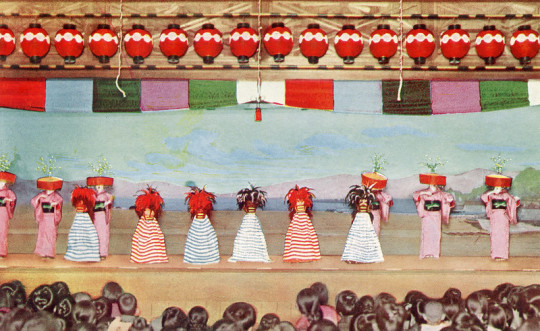
The row of chōchin lanterns, with their dango (dumpling) motifs, indicates that this is a scene from the Miyako Odori (Cherry Dance), the public dances of the Gion Kōbu geisha district in Kyoto. Probably Taishō 14 (1925), as the programme for that date has a lion dancer in a similar costume on the cover.
#Miyako Odori#Sanbiki Shishimai#japan#fashion#japanese#kimono#1920s#dance#chōchin lanterns#dango#Gion Kōbu#geisha#kyoto#Taishō
27 notes
·
View notes
Text
I could make an actual concrete reason to how the Kobayashi women keep their RCT up constantly. Along with how they acquired such a strong technique, but, my excuse is pretty monster ladies - that's all.
#// tbf my brain cells started frying in the sun#// so there's a reason I've been somewhat slow#// regardless thinking about how when sayuri can't keep up miyako odori#// she just wears a cool face mask#OUT.*
0 notes
Text
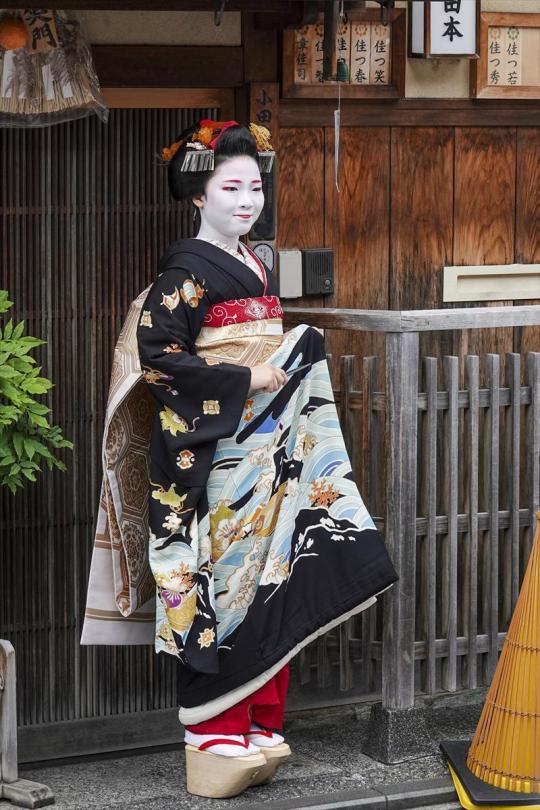
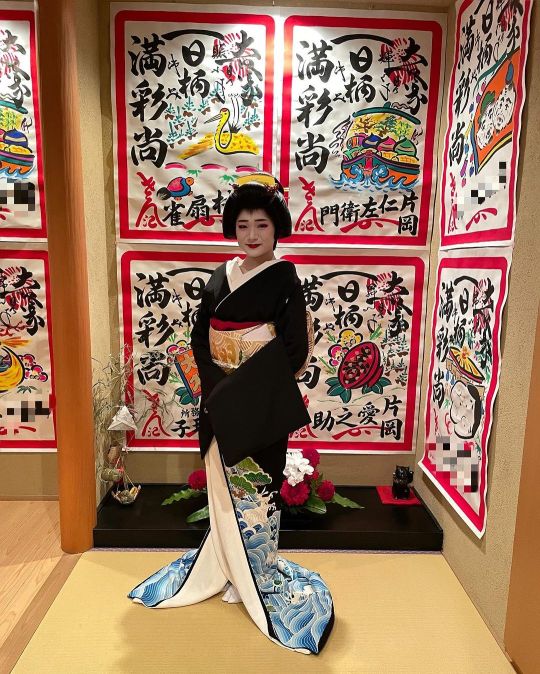
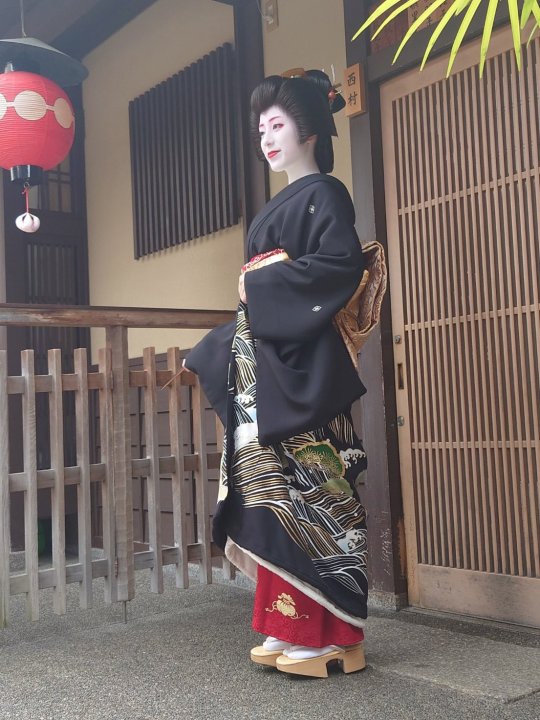
June 6th, 2024: Triple congratulations are in order across two kagai! Asako (亜佐子) of Nishimura (西村) in Gion Kobu and Masanao (満彩尚) of Man (まん) in Gion Higashi are celebrating their erikae while Katsuwaka (佳つ若) of Odamoto (小田本) in Gion Kobu is celebrating her misedashi! Katsuwaka is the imōto of Katsutomo (佳つ智), also of Odamoto, and was first seen during the Miyako Odori performing the tea ceremony under her real name as she had not yet officially been given a geimei by the time that the odori had begun. Masanao was the most senior maiko in Gion Higashi while Asako was the second most senior maiko in Gion Kobu, both with over five years of experience and stuck it out during the hard covid years. All three are wearing kuromontsuki with waves, a symbol of change and bringing luck, which will hopefully lead these women onto bright paths in the future ^^ おめでとうさんどす亜佐子さんと満彩尚さんと佳つ若ちゃん ^o^! Images are courtesy of Ono No Komachi, The Gion Higashi Kabukai, and Gion Niimi.
#maiko#geiko#geisha#kyoto#news#erikae#misedashi#gion kobu#gion higashi#nishimura#asako#odamoto#katsuwaka#masanao#舞妓#芸妓#芸者#京都#ニューズ#襟替え#衿替え#ゑりかへ#見世出し#店出し#祇園甲部#西村#亜佐子#小田本#佳つ若#祇園東
60 notes
·
View notes
Note
Hello! are there any natori geisha outside of kyoto?Also do you know if there is an online catalogue/list of the nihongami worn by geisha in general?
Hello! Yes, there are plenty of natori Geisha outside of Kyoto. Basically anyone who studies traditional arts can become natori if he/she has enough money to spend on the certificate and if the skills are good enough. "Natori" basically means someone is a master of a specific school of traditional arts and has received an artistic name by that school (for example, Kasuga Toyokikumi is a student of Kasuga Toyokigiku. The founder of the Kasuga school of Kouta was called Kasuga Toyo). There are thousands of schools of dance and instruments, and not every of those has Geiko students! Over 100 natori Geiko from all over Japan were featured in the book "Hana akari: Showa Meigiren" はなあかり: 昭和名妓連 from 1988, and you can see some Geisha who recently became natori here: https://maigeiko.tumblr.com/tagged/natori
As for nihongami hairstyles worn by Geisha in general, that is fairly simple! The standard hairstyles used all over Japan are: ※ Geiko shimada 芸妓島田 (called Taka shimada 高島田 outside of Kyoto, it's the same hairstyle and different from bridal Taka shimada) ※ Tsubushi shimada つぶし島田 ※ Chû shimada 中島田/Kyofû shimada 京風島田 (Chû shimada is used during the Miyako Odori by Geiko and Maiko that dance at the opening act Sô odori, Kyofû shimada is the same hairstyle with different decorations worn by Geiko in the entirety of Kyoto if they are on tea ceremony duty during the major Odori) ※ Maeware 前割れ
7 notes
·
View notes
Text
May 26 - Kiyomizudera (+ Sannen-zaka & Ninen-zaka) | Gion Tour
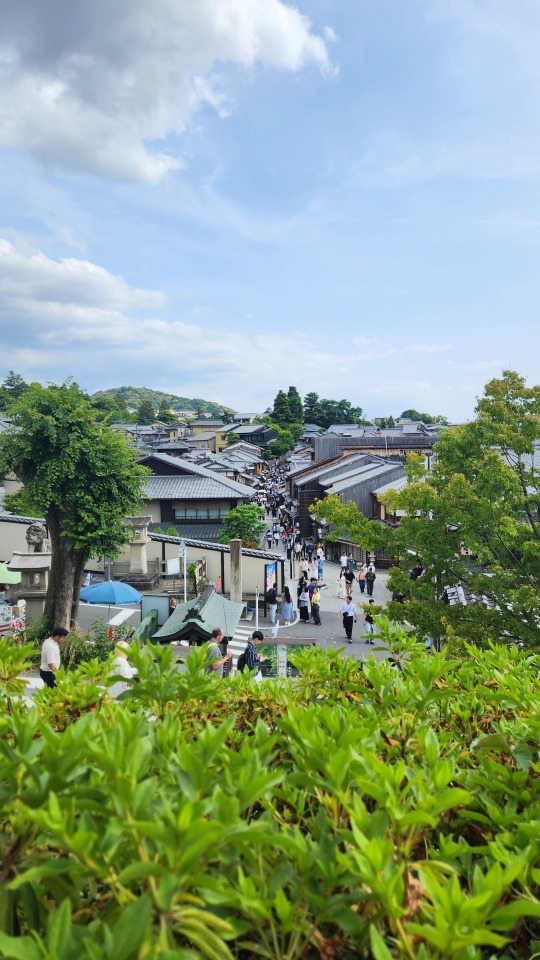
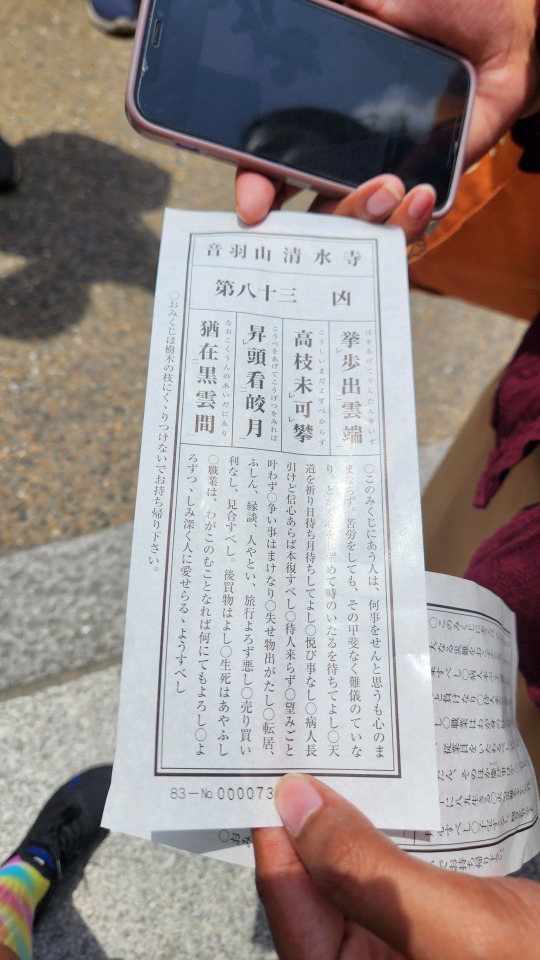
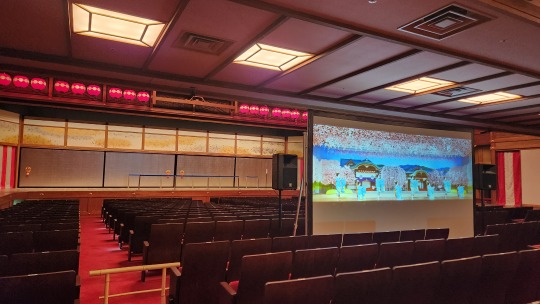
Whew! Today had so much walking. There was a lot of uphill too, so you can bet it was a tiring day. But let’s go through it, shall we?
From the train station, we walked all the way to Kiyomizudera. To get there, I think we walked on Sannen-zaka, which was one of the main roads that was lined with many small shops and restaurants. You can tell that the road was supposed to be appealing for tourists. All of the food looked yummy, and the stores sold cool trinkets and souvenirs. It was tempting to buy something, but we had to walk on. When we got closer to the temple, the paths got even steeper, but we finally made it. I got some nice pictures of the area, including the gates and the pagoda.
As a class, the first thing we did was go through the Tainai Meguri, which was this pitch dark cave that was supposed to represent a womb. After paying one hundred yen, we followed the railing made of giant beads, which guided us through the dark. At the end, there was a large stone that you could wish upon while touching it. Then, we emerged from the darkness and were “reborn.”
Next, Dr. Smith gave us some time to explore the main temple. When we entered, we tested our strength by attempting to lift these two staffs. The larger staff was too heavy for me, but I was surprisingly able to lift the smaller one. I still had a hard time lifting it though. Then, we took off our shoes to enter the area of the main shrine. We waited in line before we could bang on the metal drum gong, give a donation, and kneel to lift up our prayers in front of the shrine. Afterwards, I went up closer to the shrine to see its details. Two final things that I did before meeting up with the class was douse myself with incense smoke and buy a fortune, which ended up being the second worst based on what Dr. Smith said. I got a laugh out of it though because the first Google translation I got from it said, “Raise your cheeks and poop.”
Anyways, we proceeded to the next area, which was down some stairs. We immediately saw the Kiyomizudera Otowanotaki Falls, so the class waited in line for it. When it was my turn to get water from the streams, I made a fool of myself by trying to get water from all three of the streams. I didn’t see any clear instructions near the fountain, and I thought we could get water from all three. However, I also came to class late in the morning, so I missed the fact that you’re supposed to only drink water from one stream to get either love, success, or longevity. Therefore, I looked greedy when I was up there, so I might be cursed. My bad!
After that mishap, we left the temple area and headed down a different main road, which was most likely Ninen-zaka. At the bottom, we broke for lunch, so I ended up getting Starbucks with Lourdes, Skylar, and Anthony. Then, Lourdes, Anthony, and I went to Kyoto Bistro for real food.
When we regrouped, we headed to another temple that wasn’t too far from our meeting spot. Here, we ended up watching a presentation done by a robot that was supposed to represent Kannon. The purpose of the presentation was to spread Buddhist teachings. It was interesting to learn the Heart Sutra from a robot that blinks pretty realistically. I even got a picture with Kannon when it was done speaking.
Finally, the last place for the day was Gion. We walked all the way there. The streets didn’t seem as busy as Sannen-zaka or Ninen-zaka. Because we missed the 3pm performance, we had some time to explore the area. But my friends and I just chilled at a nearby Tully’s Coffee. Then, the class regrouped, and we headed to the Miyako Odori. We watched a beautiful performance in which a maiko danced twice, one dance with a scarf and the other with fans. I thought it was going to last longer, and I wished it did. But later on, I did get to go on a larger stage where performances occur, so that was pretty cool. Then, we all left to head home.
0 notes
